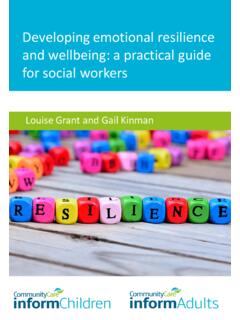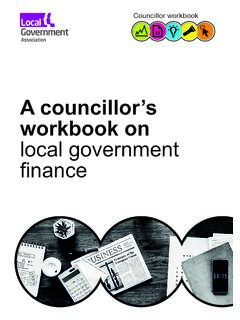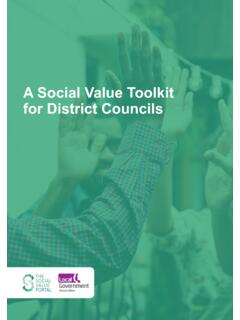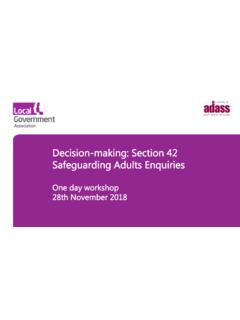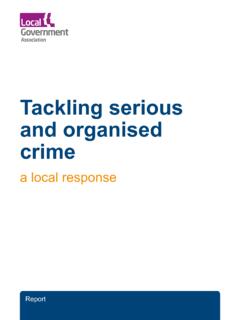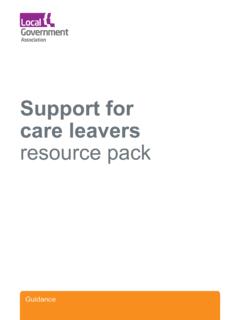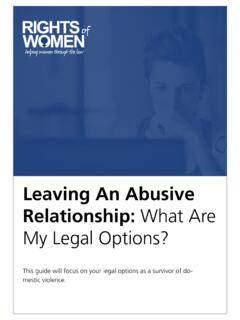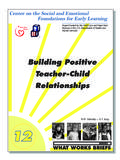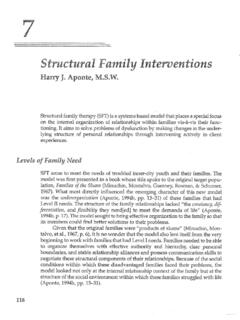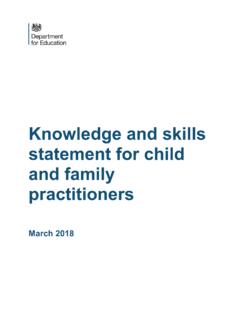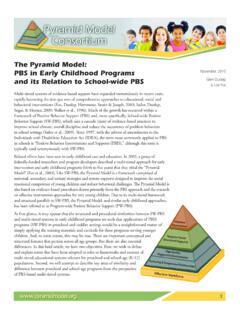Transcription of The relationship between family violence and youth offending
1 1 The relationship between family violence and youth offendingThe relationship between family violence and youth offendingReport2 The relationship between family violence and youth offendingThis review was undertaken by Chanon Consulting and Cordis Bright. The review protocol and evidence assessment approach were agreed with the Local Government Association (LGA) before the review was conducted. Please note that this is an evidence review and is not designed to be policy or practice guidance. However, it is hoped that this review could help to inform future guidance in this should also be noted that the review focusses on the link between family violence and youth offending . It does not focus on wider issues eg the over-representation or under-representation of certain groups in the criminal justice The relationship between family violence and youth offendingContents1 Executive summary 42 Introduction 83 The link between family violence and youth offending 124 Possible interventions 235 Appendix 1: Literature table 296 Appendix 2: Review protocol 47 Councils only want the best for the children and young people in their communities, but many children struggle to cope with the challenges they experience.
2 Facing continuous family violence and without recourse to adequate help when they need it, we know that some young people go on to be involved in the youth justice local leaders councils play a key role in reducing youth offending , bringing together partners through their strategic and operational role spanning enforcement, early intervention, prevention in relation to youth offending and the provision of support to victims of violence . By understanding the risk factors and commissioning interventions that support the protective factors, the link between family violence and youth offending can be rapid evidence assessment provides an introduction to the subject, and asks three key questions: What evidence exists to support a link between family violence and involvement in youth offending ? This review finds an emerging body of robust evidence for a link between experiencing family violence , and subsequent participation in youth offending .
3 The evidence shows: The more risk factors, for example, adverse childhood experiences (ACEs) experienced by young people, the greater the likelihood of participation in youth offending . Timing of experiencing family violence matters in terms of likelihood of youth offending . Stewart et al. (2008) reported a consistent finding that young people whose maltreatment persists from childhood into adolescence1, or that starts in adolescence, are much more likely to be involved in the youth justice system than those whose experience of maltreatment was limited to their childhood. 1 This review defines childhood as birth to 11 years, and adolescence as 12 to 17 evidence exists to support a link between family violence and involvement in youth offending ?What public health interventions are available to prevent offending among children and young people who have experienced family violence ?
4 If a link does exist, are there factors that moderate the relationship between family violence and subsequent involvement in youth offending ?1. Executive summary4 The relationship between family violence and youth offending5 The relationship between family violence and youth offending Young people who offend are often known to children s social care services. Hopkins, Webb, and Mackie (2010) analysed completed2 Asset and Onset profiles of young people who were convicted or deemed at risk of offending and found that 43 per cent had had previous contact with children s social services and 15 per cent had current contact. There are links between a specific sub-type of family violence and involvement in youth offending , for example, between youth offending and experiencing: sibling violence , violence against women and girls (VAWG), childhood physical abuse, child to parent violence and witnessing domestic violence .
5 Are there factors that moderate the relationship between experiencing family violence and youth offending ?This review identified six studies that found risk and protective factors experienced by a young person that moderated or exacerbated the link between family violence and youth offending . A summary of these is provided in Figure 1 and Figure 1 Protective factors influencing the link between family violence and youth offending Individual factors family factors Community factors High self-esteem Good sibling relationships High quality relationships with supportive adults Good peer relationships Safe school environmentFigure 2 Risk factors influencing the link between family violence and youth offending Individual factorsFamily factorsCommunity factors Low social competency Experience of depression Failure at school Experiences of family violence that start in or persist into adolescence Substance abuse Running away from home Delinquent peers Verbal and physical abuse with peers2 It should be noted that the social care history of young people was only completed in 65 per cent of all assets.
6 And rarely completed in onset assessments. 3 For young women only (Weaver et al. 2008) 4 For young women only (Weaver et al. 2008)5 The relationship between family violence and youth offending6 The relationship between family violence and youth offendingWhat interventions are available to prevent offending among children and young people who have experienced family violence ?As part of this review we explored interventions that are available to prevent offending among children and young people who have experienced family review identified the following interventions as having evidence at level three on the standards of evidence scale5 used in the report, ie there is good evidence that they may work in reducing violence (see Section 2 of the main report: family Nurse Partnership The Sexual Abuse: family Education and Treatment Program Big Brothers Big Sisters community-based mentoring programme Functional family Therapy (FFT) multisystemic therapy for child abuse and information about each intervention is presented in Figure 13 (Section 4).)
7 What should decision-makers consider?This review suggests that the following key messages are relevant for decision-makers: There is a well-established link between experiences of family violence , broadly defined, and participation in youth offending . There is a substantial body of evidence from large-scale quantitative studies and meta-analyses to suggest that a link exists between child maltreatment, ACEs, and youth offending . More evidence is needed to fully establish the links that exist between specific forms of family violence , and participation in youth offending . Links between specific forms of family violence 5 Cordis Bright s evidence scale is bespoke to this report and based on a review of a set of other evidence standards scales including NESTA, Project Oracle, YJB, and the Maryland participation in youth offending tend to have either mixed evidence, or support from small-scale, single studies.
8 Accordingly, decision-makers should consider focusing on addressing family violence more broadly, as opposed to one specific form of family violence . Protective factors. Decision-makers may wish to consider interventions that support the following protective factors that are correlated with a reduced likelihood of offending among young people with experience of family violence : good relationships with peers, safe school environment, high self-esteem, good relationships with siblings, and strong attachments to parents or to other supportive adults. Risk factors. Similarly, decision-makers may wish to consider interventions that address and seek to reduce the following risk factors that are correlated with an increased likelihood of offending among young people with experience of family violence : running away from home, low school attainment and association with delinquent peers.
9 Commission and fund interventions that aim to prevent and/or reduce offending among children and young people with experience of family violence . Four interventions: Functional family Therapy (FFT), family Nurse Partnership, The Sexual Abuse: family Education and Treatment Program, and the Big Brothers Big Sisters community-based mentoring programme have had evaluations that demonstrate success in reducing offending among young people with experience of family violence . However, further research is needed to assess how appropriate and effective all four programmes are in reducing offending among young people whose families are currently or previously dealing with issues of serious violence and abuse. 7 The relationship between family violence and youth offending Ensure that there is evaluation and monitoring of public health approaches for addressing offending among young people with experience of family violence .
10 Interventions reviewed here require either more evidence to demonstrate their efficacy in preventing future offending by children with experience of family violence or their efficacy in addressing offending by orking with families in family contexts where there has been serious violence . Local decision-makers should aim to contribute to the evidence base by ensuring robust evaluation (in line with recognised evidence standards) of public health approaches and other interventions that are commissioned and only want the best for the children and young people in their communities, but many children struggle to cope with the challenges they experience. Facing continuous family violence and without recourse to adequate help when they need it, we know that some young people go on to be involved in the youth justice local leaders councils play a key role in reducing youth offending , bringing together partners through their strategic and operational role spanning enforcement, early intervention, prevention in relation to youth offending and the provision of support to victims of violence .
